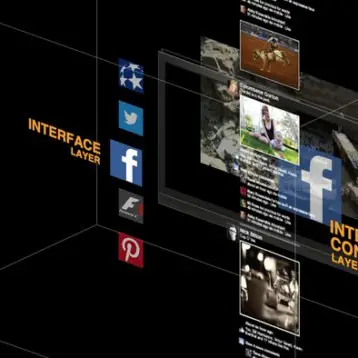The TDVisor stands at the center of this technology. This portable device reminds one of a rather bulky pair of glasses connected to a PC. When worn by the user, the TDVisor delivers a 3D stereoscopic display through a number of TDVision applications, enabling 3D visualization of various computer generated content, such as video games, computer aided design visualizations, and true 3D video streams. The result is a 720p, 108’’ diagonal equivalent screen with true 3D display with no flickering or side effects. As TDVision put it, using their device feels “just like looking at a real image through a window”. The TDVisor weighs a little less than 200 grams (6 oz) and can be fitted on top of regular eyeglasses. If necessary, the intra ocular distance can be adjusted as well. This technology allows 3D video to be transmitted to the TDVisor and be viewed on a regular 2D display at the same time.
|
Another product developed by the company is a 3D tapeless digital camera, named TDVCam, which can record 3D content in MPEG4 format. This High Definition camera, which is able to capture both stills and video, is fully integrated into the TDVisor and the related TDVision applications.
The developers, who named the virtual environment created by the TDVisor -“AlterSpace”, say the technology opens a whole array of opportunities for PC-based videogames and design studios, boosting novel graphical user interfaces and bringing 3D content into everyday use – letting users surf the web, watch movies or even have a 3D video-conference. “TDVision is pretty much what happened with audio going from mono to stereo: once you use it you don’t want to go back to your old 2D monitor” – said the company engineers.
|
One of the main problems related to “virtual reality” gaming consoles is the task of delivering a truly seamless experience. After a while, these systems often give players (especially “heavy-users”) a headache, partially due to video-audio mismatches and rapidly changing views. TDVision says it has overcome this obstacle by providing continuous views in both the left and right channels, significantly reducing the side-effects to players.
Until today, TDVision provided most of its products to researchers in the field of virtual reality, but the company says these devices will soon ‘hit the market’ under reasonable prices. Currently, the TDVisor is estimated to cost approximately $1,000. However, the company expects to lower this price to $399.
TFOT has previously written about the “VirtuSphere” – a unique virtual reality sphere which allows a person to walk, jump and even run while wearing special wireless VR glasses.You can also check out our article about MIT’s Interactive 3D Virtual Environment, which you can find here. Another video glasses solution recently covered by TFOT is Lumus, a new type of compact see-through digital eyeglasses which were also presented in CES 2008.
You can find more information about TDVision technology at the company’s official website.











